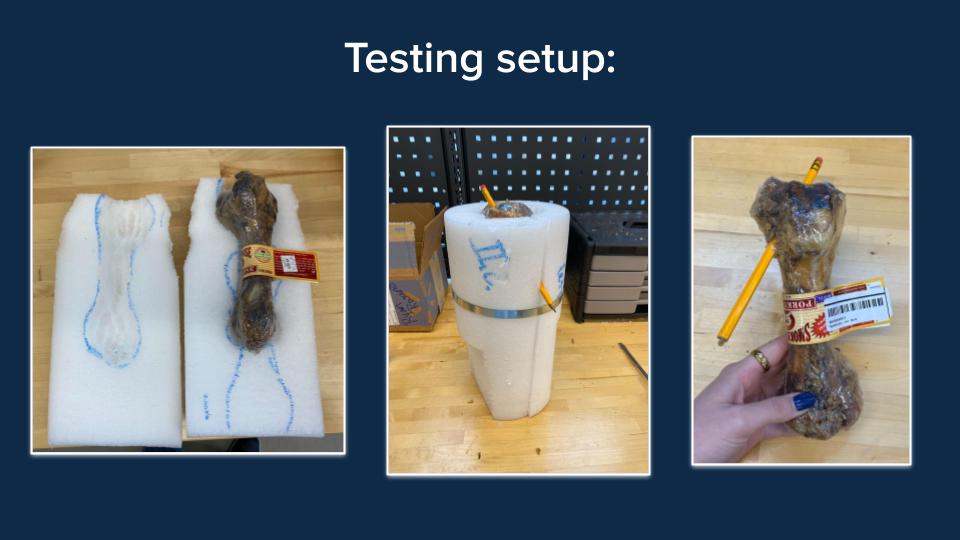Testing Summary:
Tests were conducted on the basis of evaluating drill guide performance and operation when used as a tool to execute an ALLR (Anterior lateral ligament reconstruction) procedure in conjunction with ACLR (ACL reconstruction). Out of all our functional requirements, the testing protocol aimed to assess three important functional requirements: tunnel convergence, adjustability, and minimizing the number of portals. Tunnel convergence is the main objective of the guide and testing will confirm that the drill guide design can be oriented in such a way that drill an ALLR procedural tunnel while ensuring a conflict with the ACLR tunnel does not occur. Adjustability is also crucial since patients vary in size and therefore different knee sizes should be accommodated for.
Setup Procedure:
- Using a saw, flatten out the far end of the foam so it is sturdy in a clamp.
- Cut foam long ways down the center to open it up.
- Hollow out foam to fit a pig femur inside where the hip end of the bone is in the center of the foam and the distal end reaches the top of the foam (porcine femur was chosen since ACL / ALL ligaments are similar to those of humans [1] and porcine femurs have are established in literature as stand-ins for human cadavers [2]).
- Orient the bone in foam so the anterior of the bone will be facing up in the clamp.
- Shave down 2 of the foams so the knee end will be smaller to represent a different sized leg.
- Remove bone from the foam and mark location to drill ACL tunnel.
- Check angle of ACL tunnel is between 40 and 50 degrees from horizontal [3] using measure iPhone app.
- Clamp bone to workbench and drill ACLR tunnel using an 8 mm bit (size of ACLR drill).
- Insert pencil into tunnel to simulate an ACL graft.
- Place bone back inside foam and poke pencil out of foam so tunnel is visible.
- Clamp foam and bone to workbench.

Testing Procedure:
- Set up drill guide prototype on bone as directed by the respective subteam.
- Insert 6 mm drill (reamer used for ALL surgery) into the prototype and drill into foam and bone using the prototype.
- Repeat 2 more times using different sized foam and both left and right femurs.
Evaluation Procedure:
Tunnel Convergence:
- Remove the 8mm pencil from the hole and check for damage to the pencil.
- If there is damage on any of the three pencils, mark the prototype as a failure. Otherwise the drill guide passes the tunnel conflict test.
Adjustability of knee size:
- Does the prototype pass tunnel convergence test on both knee sizes (small and large) as well as both leg sides (left and right)?
- If it avoids tunnel convergence using the procedure above for both sizes and sides, mark as yes.
* Adjustability was not fully evaluated in this testing round due to a small number of trials
Minimize number of portals:
- Count the number of incisions cut into the foam (additional to those used in normal ACLR) needed to use the prototype.
A summary of results from the Dune test may be found here.
A summary of results from the Oasis test may be found here.
[1] https://link.springer.com/article/10.1007/s00402-016-2529-2
[2] https://link.springer.com/article/10.1007/s00167-009-0916-8
[3] https://www.ncbi.nlm.nih.gov/pmc/articles/PMC5442353/